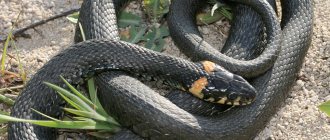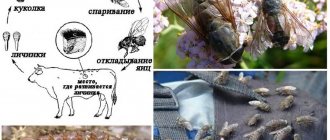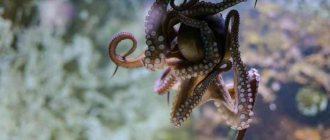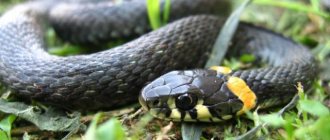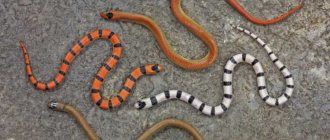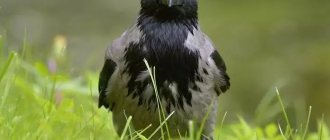The iguana, like the chameleon, is considered the most common domestic lizard. It is started by lovers of exotic animals who are not impressed by traditional pets - cats and dogs.
An iguana is a simple, beautiful reptile that is pleasing to the eye; it does not catch any insects, as a chameleon does, and therefore is not useful. The iguana has its own habits, but what does this animal eat? Where does it live, how should you care for your pet at home, and is it dangerous? Read about it below.
What does an iguana look like?
- An iguana is a large lizard. The animal's body length is approximately 2 m. Average weight is 7 kg. But in nature you can find much smaller representatives of this species, for example, the blue iguana. The lizard is covered with spines, its body length is no more than 30 cm.
Blue
- The iguana, like other lizards, is covered with scales. The scales themselves, depending on the type of reptile, can be of different sizes and colors.
- The animal has the ability to change its own color, but does not do it as easily as a chameleon. The shade of a pet depends on the temperature at which it lives. If the environment is cool, the reptile's skin becomes dark, but if it is hot, it becomes bright.
- Various species of lizards have their own colors. Typically, an iguana's color is designed to help it blend in with its surroundings as much as possible. For example, the iguana that lives in the jungle is green.
- A characteristic feature of the iguana is that it has a spiny crest located on its spine. This comb decorates the pet's appearance and also protects it.
- The iguana has a thin spine, a fairly flexible body, which is flattened on the sides. It is thanks to this structure that the animal quickly climbs even in narrow crevices.
- The lizard has a large tail , which is much larger than the body. It is muscular and helps the reptile while moving. If something threatens the iguana, it casts off its own tail, which grows back after a while.
- The iguana's paws have sharp claws. They are necessary for self-defense. With their help, the animal can also move along various uneven surfaces and climb trees, if necessary.
Exotic
- The lizard's teeth resemble human teeth in structure and can also regenerate if they fall out.
- The iguana's tongue distinguishes tastes and aromas. Sometimes it replaces the nose. Therefore, the reptile has an excellent sense of smell and navigates the world of aromas.
- The iguana's eyes see even when closed. This is because the lower eyelids have a special depression that prevents the eyes from closing 100%. That is, the lizard is physically unable to close its eyes completely. This eye structure sometimes helps the iguana during self-defense.
Varieties
There are 45 recognized species in the iguana family, including several endangered species. These cold-blooded creatures come in different shapes and colors. Their size varies from 12.5 to 200 cm, more than half of which is on the tail. The body weight of adult individuals ranges from 30 grams to 14 kg. Moreover, males are usually larger and heavier than females.
Photo: VALERIE T.
The most famous species is the common or green iguana (Iguana iguana). It is found in the territory from the southern regions of Mexico to Brazil. She can often be seen basking in the sun on tree branches overhanging the water. The common iguana is green with dark stripes forming rings on its tail; females are grayish-green, weighing about half that of males.
- The longest iguana is the green iguana, which has a body length of 1.5 to 2 meters, including the tail.
- The smallest iguana is the spiny iguana, growing from 12.5 to 100 cm in length, including the tail.
- The heaviest iguana is the blue iguana, gaining weight up to 14 kg.
Types of iguanas
There are approximately 40 species of iguanas in nature. The most common are the following:
- Common iguana. It is considered the largest and most famous. Lives in Central and South America. Can be a maximum length of 1 m 50 cm, weighing no more than 4 kg. The color of the lizard varies. It all depends on where exactly the pet lives. There is a crest on the back of the iguana. In the chin area there is a pouch necessary for thermoregulation. It also helps the lizard attract the opposite sex during mating season.
Ordinary
- Black iguana. The reptile lives in Mexico, in rocky areas. The maximum length is 1 m 40 cm. The iguana has a short head. On the back of the lizard there is a crest that extends to the tail. It has spikes designed for self-defense. The iguana eats flowers, fruits, and foliage.
Black
- Madagascar iguana . It grows to a maximum length of 30 cm, but sometimes slightly larger individuals are found. The color of the lizard is dark brown, there are spots and stripes on the body. The male has a bright comb on his head. The lizard lives in the sand dunes of the island of Madagascar. It feeds mainly on plants and small insects.
Small size
- Blue iguana. Considered a rare species, habitat is Grand Cayman Island. The lizard prefers to live on the sea coast; it also likes open areas, rocks, and dry forests. The length of the iguana is a maximum of 1 m 50 cm.
- Striped Fijian iguana. A small reptile, the length of which is no more than 1 m. The color of the iguana is bright green. There are wide light stripes along the entire body. When the reptile is aggressive, or during the mating season, the male iguana turns black.
Striped
- Desert iguana. The tail of this iguana is 40 cm, the animal has a dense body. The color of the animal is gray or brown; there are also small light spots in the black border. The lizard lives in North America closer to Mexico. Feeds on local vegetation. But sometimes it can try insects and smaller reptiles.
Light reptile
- Collared iguana . Lives in Mexico, United States. The length of the iguana is only 35 cm. The color of the animal is beautiful, bright, for example, yellow, green. At the same time, there are black spots on the reptile’s head.
Bright
Terrestrial and semi-aquatic species
Land iguana species usually have a more or less disc-shaped, flattened body. Desert and rocky species are usually colored to match the color of the soil on which they live, while the color within the species is very variable, as it is determined by the color of the soil, air temperature, and light brightness. Some desert species are able to “swim” in the sand, plunging beneath its surface, however, there are few true burrowing species. Many species use the burrows of rodents and other animals. Some species of iguanas are semi-aquatic ; they swim well; for example, the marine iguana spends most of its life in salt water.
Where does the iguana live?
- The iguana leads a diurnal and terrestrial lifestyle. This is not a predatory animal, but a peaceful one. The iguana, when it sees danger, runs away, but never attacks. For her, a person who mercilessly kills other animals is considered more aggressive.
- Since the iguana moves only during the day, it has excellent eyesight and can see threats from afar. The lizard is cold-blooded and lives in warm places. Therefore, in order for an animal to live longer at home, it needs to be provided with normal conditions.
- As mentioned above, the iguana is considered a large lizard. It can live on dry islands, as well as on the shores of water bodies. In this case, the habitat depends on the type and genus of the reptile.
Iguana
- For example, a small iguana with an exotic coloring lives in the tropics with a lot of vegetation, where there are few predatory animals. Thanks to this environment, the lizard can “relax.”
- Many iguanas live in thickets where there are a lot of different plants, because this is where they can hide faster. An additional important factor in this habitat is the large amount of food.
- Iguanas can harm other animals because they eat some crops necessary for the nutrition of some individual. They also destroy burrows without noticing it.
Nutrition
Green iguanas are vegetarians. Their body is not able to digest animal protein. Insects or their larvae can enter the lizard's body only by accident - along with the leaves and fruits of plants.
Some researchers claim that a hungry or captive iguana can eat a small animal. This is true. But constantly eating protein-rich foods does not lead to anything good.
In its natural environment, the lizard feeds on leaves, fruits and flowers of tropical plants:
- Jamaican plum;
- incense tree;
- thecomoy;
- Merremia.
In total, there are more than 100 plants that the iguana eats.
What do iguanas eat?
- The iguana is not a predator, so it does not eat insects, eggs, birds or small animals. The digestive system of these animals has developed over centuries; it is tuned to the assimilation of plant foods. Thanks to this diet, the reptile receives proteins and other useful substances.
- In the wild, an iguana can eat very little meat, but only the portion that does not harm it. At home, the animal needs special nutrition.
- For an iguana, the most important thing is its diet, plus the correct diet. Also, environmental factors play an important role for the normal life of a reptile. They must be taken into account.
- The lizard needs to be fed daily. An adult iguana should be fed once a day, while a young iguana needs to be given food several times.
- warm up before eating .
- The reptile must eat food strictly on schedule, at the same time. The last meal is a few hours before the animal goes to sleep.
- the lizard menu varied. It is advisable to give the iguana at least 10 different foods, but, at the same time, you need to take into account that the lizard loves a stable diet.
- The reptile will take more types of plant food, making it easier for it to create a balanced diet for 7 days.
Iguana food
- The animal must take the required amount of calcium so that the pet develops normally, its claws and teeth grow quickly.
- A young iguana requires protein , which should make up 1/5 of the total diet. This substance is found in legumes, mustard, and dandelion.
- To keep the reptile's body hydrated, it needs clean water at all times. Vegetables, herbs and fruits that contain a lot of moisture will also help.
The iguana's diet should consist primarily of the following products:
- Greens (cabbage, leeks, legume leaves, spinach).
- Vegetables (turnips, sweet peppers, zucchini, corn, parsnips).
- Fruits (pears, bananas, grapes, watermelon, tropical fruits, apples).
Also, the iguana's diet should include boiled oatmeal, bran, boiled buckwheat, unsalted rice, and bran.
Accommodation
You should not allow your iguana to roam around the house. Otherwise, the following will happen: your house will be destroyed and your iguana will be injured. Most often, a lizard breaks its tail. Most often, the tail will grow back later, but it will never look as beautiful again. The iguana can also swallow small objects, which can only be removed by a surgeon. Well, and besides, a long stay outside the cage will negatively affect the temperature of your animal; it may become hypothermic.
To house an iguana, you need a large and spacious terrarium or a polyurethane or glass cage. It is worth considering that iguanas can reach a length of 1.80 m and a weight of 8 kg. The terrarium should be approximately three times the length of the lizard itself. You should not choose a wire house: many iguanas have the habit of rubbing their nose against the bars and injuring themselves. The cage should be cleaned at least once a week, and preferably more often. When cleaning the terrarium, never use soap, liquid cleaner, etc. The smell of chemicals alone can kill your iguana. The cage can only be cleaned with a sponge or cloth soaked in warm water. As a last resort, use baking soda.
Be aware that iguanas carry Salmonella bacteria. They pose no harm to the animals themselves, but can cause serious eating disorders in humans. Be sure to wash your hands with soap after every contact with your pet.
Iguana at home: is it possible to keep it, is it dangerous?
- If you are trying to find some kind of exotic animal to keep in your apartment, then we advise you to pay attention to the iguana. The lizard has a bright appearance, an interesting lifestyle, and a very kind character.
- She quickly gets used to her owner and also quickly makes contact with the person. From here we can draw one main conclusion - the iguana does not pose a danger to humans, it can be kept in an apartment, at home, without fear for its own health.
The lizard is good-natured
How to choose a healthy lizard at a pet store
It is recommended to buy an iguana in July-August. The body length of a two-month-old reptile, not counting the tail, is 15-17 cm. Even professionals cannot determine the sex at this age.
When buying an iguana at a pet store, you need to pay attention to the following nuances:
- the skin is clean, without damage;
- the tip of the tail and comb without dark spots;
- around the anus is clean;
- the reptile stands confidently on all 4 legs;
- eyes are clean, without swelling;
- there is no discharge from the nose;
- the oral cavity is pink;
- a good appetite.
The activity of an iguana when communicating with a person is a sign of its health.
Before purchasing an iguana, you should familiarize yourself with the health signs of your future pet.
Watching iguanas is very interesting for both adults and children. Owners are attracted by the reptile's pleasing color and unusual behavior.
Iguanas do not make noise and are not annoying. Of course, unlike cats and dogs, a cold-blooded lizard will not give affection and warmth to its owner, but affection and recognition are characteristic of it.
Would you like to have an iguana as a pet? What qualities of the reptile attracted you? Share your impressions in the comments.
Iguana: keeping at home
The iguana is a heat-loving animal. Therefore, its maintenance requires conditions that are as close as possible to natural conditions.
Terrarium
- The temperature in the terrarium must be a minimum of +28°C and a maximum of +40°C. If the temperature is below +28°C, the pet may die. To maintain the desired temperature, you need to install a heater under the terrarium.
- is installed above the terrarium itself . Thanks to it, the animal will receive ideal light, which maintains the pet’s body in normal condition.
- Since the iguana loves warmth and moisture, it requires a small pool. It must be filled with drinking purified water. In addition, the iguana loves to bask in the water. Thanks to her, she will be able to quench her own thirst at any time.
In the terrarium
- a mat inside the terrarium ; the reptile does not need stones with sand, since the iguana will want to try sand, which does not bring any benefit.
- You also need to create ventilation . If this is not done, the pet will begin to get sick and eventually die. The best option for natural ventilation is a slot, which must be covered with a strong mesh.
- I would like to note that the terrarium should only be located in a quiet place where other pets do not reach. The lizard will not be able to make friends with them.
Home maintenance
Keeping a green iguana at home is quite difficult. She requires constant specific care. Under the right conditions, the lizard will live 15–20 years. In their absence, no more than 2–3.
To keep a reptile at home, you need to purchase a terrarium. It should be spacious and well ventilated. As the lizard grows, its size should also increase.
Air temperature is of great importance. Iguanas are cold-blooded animals, so the climate greatly affects their health. The terrarium must be equipped with heaters. The optimal air temperature is from 26 to 35˚С.
Included with the heater, you must purchase an ultraviolet lamp. Basking under its rays, the pet will receive the necessary amount of vitamin D. This element promotes digestion and absorption of calcium. Insufficient lighting levels lead to the development of bone diseases and the death of the animal.
In addition, the terrarium must be equipped with a small pool with warm water and thick tree branches. There it will be easier for the lizard to bask under the lamp. All accessories can be purchased at a pet store or from a breeder.
Iguana: care at home
In order for your iguana to have a comfortable life, you will have to follow the following care rules:
- The terrarium must be constantly cleaned, as leftover food and feces can cause the spread of various harmful bacteria. For such purposes, you can use special cleaning products that do not contain chlorine. Clean the terrarium once every 7 days.
- Trim the reptile's claws, removing only the tips so as not to touch the veins.
- Develop a special regime for your own pet. The animal should sleep for 12 hours and stay awake for the same amount of time.
- If it's hot outside, go outside with your reptile and take a walk with it.
Walking with an iguana
Iguana loves to bathe and swim. Thanks to this lifestyle, she develops normally. Bathe your pet 2 times every 7 days. The following instructions will help you with this:
- Before bathing, warm up the walls of the bathroom.
- Fill with water whose temperature is no more than +35°C.
- Place a piece of driftwood in the water so that the reptile can climb onto it for a while. Water your pet to keep his body warm.
- The duration of the procedure is approximately 30 minutes.
- When you finish bathing, dry the lizard with a towel and place it in a heated terrarium.
Character traits
Coloring
Iguanas come in a variety of colors—usually bright green, blue, black, brown, gray, and orange—and these different color morphs often depend on where they originate. Woody species come in different shades of green, blue and yellow to blend in with their treetop environment.
Photo: floridensis
Lizards may have dark transverse stripes on the body and tail, shaded by light veins. The stripes can be jagged and discontinuous, forming a kind of "carpet pattern" .
Appearance
Iguanas have a slender body, slightly compressed laterally, a large head and a long tail with a jagged ridge that runs from the head to the base of the spine. The limbs are muscular with long toes and sharp claws. They may also have grooves on their tail and body.
These lizards have a vestigial third eye on the top of their head, known as the "pineal gland." It is sensitive to changes in light levels and movement. Iguanas also have a flap of skin hanging from their chin called a dewlap. The movement of the dewlap is the way iguanas communicate.
Photo: katrinapeebles
Natural adaptations
Because these highly adaptive animals can be found in a wide variety of habitats, each species has its own unique adaptations.
Marine iguanas of the Galapagos Islands are skilled swimmers . They usually limit diving to just a few minutes, but can stay underwater for up to 30 minutes. Their black color helps them warm up after being in the chilly waters of the ocean.
The green iguana is at home high in the trees of the rainforest. Other species, on the other hand, have natural adaptations that allow them to successfully survive in hot deserts or rocky areas.
Photo: BioLib
With an emerald body coloration with blue/white stripes, more noticeable in males, Fiji iguanas inhabit a variety of habitats, from coastal wetlands and lowland woodlands to tropical forests on the volcanic slopes of the archipelago. They are characterized by long toes with pointed claws and elongated tails that help them maintain balance in the treetops. Rarely found on the ground, these striped iguanas climb from tree to tree using overlapping branches.
How long do iguanas live?
- If an iguana lives in its natural environment , its life expectancy differs significantly from that at home. The pet feels great in nature and can live in the wild for more than 30 years. If the reptile lives in an apartment, its age can be a maximum of 20 years.
- The average age of pet iguanas is 15 to 20 years. When purchasing a lizard, it is better to contact a professional breeder. He knows the age of the pet in advance and will help you choose the necessary climatic conditions for the animal.
Habitat and lifestyle
In nature, green iguanas prefer to live in humid, warm climates. Their habitat covers the tropical forests of Southern and a small part of North America, islands in the Caribbean Sea.
They settle in places with dense vegetation, mango thickets or near bodies of water (sea shores, rivers, streams). They are active only during daylight hours. During the day they bask in the sun, maintaining body temperature. At night they rest on the lower branches of trees. Life expectancy in natural conditions is approximately 8 years.
Iguana keeping in an apartment: reviews
- Irina: “The iguana is considered a herbivorous animal. She is harmless, but does not like children. We were able to find an approach to our pet, so he quickly adapted to us. We feed the reptile various plant foods. Caring for an iguana is not difficult, but sometimes it needs our attention.”
- Svetlana: “I bought an iguana about 5 years ago. I love such exotic animals. Our beauty lives in a separate terrarium, which I clean regularly.”
- Sergey: “I have an iguana living in a separate cage for about 3 years. I take her for walks regularly (if it’s hot outside). I also try to monitor the pet’s nutrition, bathe it regularly, and clean the inside of the cage. The animal is suitable for those who love the exotic.”
We recommend reading useful articles on our website:
- Aquarium snails - large, small
- The cat abandoned the kittens and does not want to feed them
- I can’t cope with death, the loss of a cat: what to do
- What distinguishes an ape from a human?
- Scottish Fold cat
- Turtles in nature - the world around us


